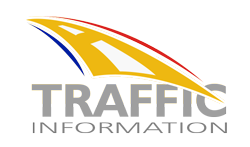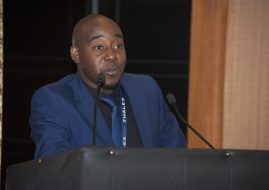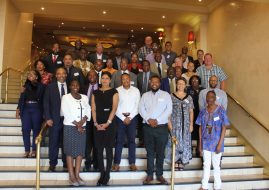35 Years in selfless Pursuit of Safer African Skies
(Peter Marais retires after more than three decades in South African aviation)
Johannesburg, South Africa – 19 December 2016: Air Traffic and Navigation Services (ATNS) SOC Ltd has lost one of its pioneers – to retirement.
Peter Charles Marais matriculated from the Pretoria Boys High School with a university exemption. Like most young men at the time, he completed his military service and enrolled at the University of Pretoria in 1976. He graduated with B. Ing (Elektron) in 1982.
In the same year, Peter joined the Department of Transport as the Principal Radar Engineer. He was responsible for the acquisition and deployment of primary and secondary radar systems as well as air traffic management systems – used by the Department of Transport’s Directorate of Civil Aviation (DCA) throughout South Africa.
With the establishment of ATNS in 1993, Peter became one of the first employees and founding fathers of ATNS, in the official capacity of Manager Engineering. He was instrumental in the “storming and norming” phase of the newly established entity, developing the first ATNS Ten Year Infrastructure and Investment Plan. As ATNS evolved, Peter grew with the business and was soon promoted to Divisional Manager, Avionics Services, responsible for the communication, navigation surveillance and Air Traffic Management systems planning, specification, acquisition and implementation.
In his farewell speech – Peter said when ATNS was incorporated in 1993, he was one of the few who was selected and appointed to be part of the new management that took over the Air Traffic Management services from the DCA. “We took over the operating assets of the DCA and the staff who elected to be transferred to ATNS with effect from 1 April 1994. We have since grown from there to what we are today”.
Peter went on say that “the infrastructure that was transferred to ATNS was largely old and past its useful life. Some of our navigation aids dated back to the late forties and our radar systems located largely at the main airports dated back to the early seventies. Our air traffic management systems at OR Tambo and Cape Town International Airports were relatively new having been commissioned in the mid-eighties and early nineties”.
During 1998 the International Civil Aviation Organization (ICAO) ranked Africa and Latin America as the world regions with the least safe air transportation networks. This was also the year when Peter moved away from his engineering roots and became General Manager Business Development – where he was responsible for looking beyond the borders of South Africa to grow the influence and business of ATNS. He conceived the concept of a regional aeronautical satellite communication system that was intended to address the telecommunication shortcomings.
The birth of SADC (Very Small Aperture Terminal) VSAT – which to this day operates effectively – still contributes to the financial well-being of ATNS.
With the advent of the new millennium (in 2000) Peter became the General Manager Technical Services, returning to his engineering background for the next six years. His experience and general ability to lead resulted in his deployment to a number of Executive assignments. 2010 was not only an eventful and memorable year for South Africa but also for Peter. During that year ATNS transitioned its air traffic service delivery from Durban International Airport to the newly-built King Shaka International Airport. ATNS successfully delivered service for the 2010 FIFA World Cup, with Peter as the Executive Operations.
Peter has become known throughout the national, regional and global aviation fraternity – for his strategic thinking ability and the calm and analytical approach he brings to any situation. He is a recognised figure, mentor and coach and role model for many aviation professionals.
Peter personal highlights are many and varied, but there are a few of those that stand out in his memory. These are:
- The SADC VSAT network which consumed two years (1998 – 2000) of his life, saw Peter travelling extensively in the SADC countries, persuading and cajoling first the SADC Civil Aviation Committee and then each state to sign up for the service. After many visits, he concluded the contract with Tanzania for the installation at Dar es Salaam. One of the most rewarding experiences was being a guest of honour at the inauguration of the terminal in Dar es Salaam and witnessing the first direct call between the Dar and Kinshasa Air Traffic Controllers (ATC) centres in 20 years. The Other States in the continent quickly followed suit.
- In 2003 Peter was the Chairman of the Technical Committee of the ICAO 11th Air Navigation Conference that laid the foundation for the technologies and systems that are being implemented today. It was two weeks of hard and stressful work marshalling 600 delegates towards a common outcome. The conference laid the groundwork for many of the activities that we are implementing today such as Performance Based Navigation (PBN), Continuous Climb Operations (CCO) and Continuous Descent Operations CDO, DME/DME (Distance Measuring Equipment) networks as a backup to the GNSS and Mode S 1090ES as the global standard for the role out of Automatic Dependent Surveillance – Broadcast (ADS-B);
- Being the chairman of the SADC Upper Airspace Control Centre (UACC) Steering Committee for eight (2000 – 2008) years during which time the UACC Steering Committee carried out two feasibility studies that showed that regional air navigation service provision is not only feasible but also desirable. The Committee also made such a good case to the SADC Heads of Government to approve the establishment of the UACC and asked the SADC Secretariat and the SADC States to implement the concept. Sadly, it has become bogged down in perceptions related to security and sovereignty;
Peter suffers fools with great difficulty, yet decorum. He may seem stern, yet underneath the surface, he is a gentle and likeable fellow. Peter’s influence in the aviation industry and the achievements of more than 34 years (20 at Executive level in ATNS) leaves a legacy which will be difficult to follow.
ATNS CEO, Thabani Mthiyane said, “As he approaches the sunset of his ATNS career we salute his achievements and wish him well in the next chapter of his adventures”.
Related Posts
« 2 Adults and 7 children injured in crash on the N2 at Sir Lowry’s Pass Newly appointed constables deployed for Safer Festive Season in Northern Cape »






























